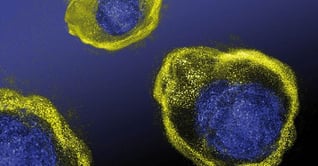- Other Products
- CCP
Gene therapy is a promising technology with the potential of helping some of the hundreds of millions of people that live with genetic disease worldwide. In recent years, there has been a surge in interest for the technology and there are a large number of ongoing clinical trials. There are over 200 genes known to be involved in retinal diseases, some of which are tempting targets for gene therapy.
Much of the focus in the development of recent gene therapeutic therapies has been on retinal rare diseases, that result from modifications in a single gene. These retinal diseases tend to have clear genomic targets as well as high unmet need in patient populations and patients have generally been underserved by other more traditional, therapeutic treatments - making them ideal targets for retinal gene therapy.
At Svar Life Science, we are witnessing this rise in interest for gene therapy firsthand. A number of pharma companies have engaged us regarding the development of assays related to the technology.
Most projects involve retinal gene therapy, which is not surprising considering the number of advantages the eye offers.
![]() First, the enclosed nature of the eye and that it is relatively immune privileged mean that the immune response against the viral vector will be weaker, increasing the probability of success.
First, the enclosed nature of the eye and that it is relatively immune privileged mean that the immune response against the viral vector will be weaker, increasing the probability of success. ![]() Second, retinal cells do not proliferate after birth. This is important as a single injection could potentially offer life-long expression of the therapeutic protein.
Second, retinal cells do not proliferate after birth. This is important as a single injection could potentially offer life-long expression of the therapeutic protein.
![]() Third, a number of animal models are available for inherited retinal diseases, which is instrumental for safe and efficient drug development.
Third, a number of animal models are available for inherited retinal diseases, which is instrumental for safe and efficient drug development.
In many ways, the retina is contained in a unique environment. The eye is protected by physical barriers that prevent pathogens, cells and molecules from entering the eye. As a consequence, the eye is not part of the lymphatic system which means that circulating antigen-presenting cells do not have access to the eye. Instead, the eye has its own sophisticated system to regulate immune responses.

As the retina is immune privileged, it needs a specialized defense system to protect the eye. This system consists of innate immune cells combined with the complement system.
We offer tools for the analysis of the complement system. Our functional assessment solutions can be used to analyze activity from all three major pathways independently, and our biomarker assays can be used to measure the activity of individual components of the complement system.
At Svar Life Science we have seen a rise in interest of retinal gene therapy first hand. As there are over 200 genes known to be involved in retinal diseases, there is no shortage in potential candidates for gene therapy.
Lately, we have been engaged by many pharmaceutical companies interested in assistance with designing reporter-gene assays.
Currently we are helping customers by developing custom made reporter gene cell lines for potency assays applicable for many highly complicated systems and therapeutic modalities originating from the retinal system, ocular disorders and other ophthalmic therapies.
Our unique cell-based iLite®technology is a powerful cell-based technique used to measure and quantify gene therapy targets. With our in-house expertise and processes we have a high success rate and can create an iLite cell line for almost any biopharmaceutical target.
We also have a number of off-the-shelf assay-ready cell lines, for a variety of targets, available.
Demonstrating safety, quality, and potency of the final retinal gene therapy product is a major challenge as assembling the different drug components in a functional manner after transfusion is a precarious process.
Here, bioassays are considered to be more reflective of the in vivo situation and iLite cell-based bioassays enables functional biological readout, showing relevant therapeutic activity or intended biological effect, of a product's mechanism of action.
Our Bioanalytical Service unit offers assistance throughout the entire retinal gene therapy drug development process – by not only developing and validating an assay, but also performing the sample analysis and providing a final report for regulatory approval.
Our Bioanalytical Services have long experience in creating assays for a wide range of projects and can help you create the optimal assay for your target.
The Bioanalytical laboratory is GLP compliant and work according to GCP. As of Q2 2021, bioassay method development, transfer and validation will also be offered under GMP. This enables a fully integrated chain from assay needs based on modality, through specific cell lines for that purpose to a fully validated potency assay for batch release of a drug.
Our Bioanalytical Services have long experience in developing assays for a wide range of projects and can help you create the optimal assay for your target.

Cell-based solutions based on the iLite technology, a cleverly engineered cell-based assay system with a dual reporter gene readout, that can be developed for virtually any pharmaceutical target.
An easy, rapid and accurate test format for measurement and quantification of drug activity and immunogenicity.

The complement system is believed to play an important role in this change and there are several complement-based clinical trials for retinal diseases.
We have the solutions and knowledge to help you navigate this complex area.

Bioanalysis as a critical tool during the process of drug discovery. Development and assays are continuously being developed to support the various stages and requirements.
We offer assay development, validation and samples analysis within our Bioanalytical Service Solutions.